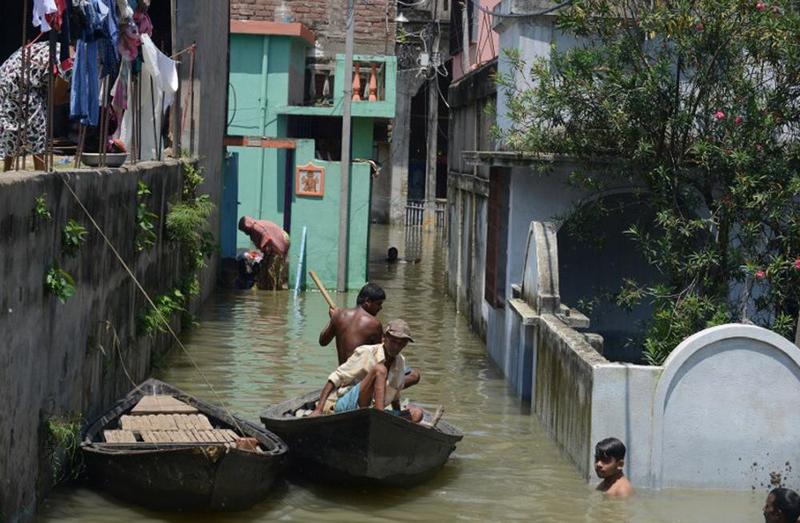UN: Asia-Pacific faces more damaging disaster threat
Natural disasters could become more destructive in Asia-Pacific, where a person is already five times more likely to be affected than in other regions, the United Nations warned on Tuesday, urging countries to invest in resilience plans.

Home to 60 percent of the world's population, Asia-Pacific is the planet's most disaster-prone region.
Last year, floods, storms and extreme temperatures killed 4,987 people - far fewer than the annual average since 1970 - and affected some 34.5 million, according to the Asia-Pacific Disaster Report 2017.
Poor and lower middle-income countries, which are typically least able to prepare for and respond to weather hazards, suffered about 15 times more deaths from disasters than richer Asian nations, said the report released by the United Nations Economic and Social Commission for Asia and the Pacific (ESCAP).
Disasters can have "deeply disruptive effects on livelihoods" and further disadvantage already vulnerable people, many in rural areas, pushing more into poverty, it said.
In addition to the human costs, the ESCAP research indicated that between 2015 and 2030, 40 percent of global economic losses from disasters would occur in Asia-Pacific.
"It also shows that future natural disasters may have greater destructive potential," ESCAP said in a statement.
The commission said disaster risks exacerbated by climate change were likely to increase in the region.
They include more life-threatening heatwaves, worsening floods and droughts, more frequent and powerful tropical cyclones, and heavier monsoon rains in East Asia and India.
ESCAP head Shamshad Akhtar urged countries to fill gaps in their plans for dealing with disasters.
"The absence of an institutionalized insurance culture and adequate post-disaster financing threaten our extraordinary economic and developmental achievements," she said.

According to the report, the countries facing the greatest economic losses from disasters are the region's largest economies like Japan and China.
But its least-developed and small island nations could be hit hardest, losing between 2.5 and 4 percent of their gross domestic product annually.
ESCAP called for actions to mitigate disaster risk linked to climate change, including setting up a regional early warning system and investing in disaster risk education.
It said building disaster resilience into agricultural development plans was important, as studies showed most poor people in Asia-Pacific are farmers in rural areas.
"It is... critical for improving livelihoods and reducing poverty," the report said.

Indian residents wade travel through flood waters in Malda in the Indian state of West Bengal on Aug 24, 2017. The United Nations warned on Oct 10, 2017 that natural disasters could become more destructive in Asia-Pacific, where a person is already five times more likely to be affected than in other regions. (DIPTENDU DUTTA / AFP).
Home to 60 percent of the world's population, Asia-Pacific is the planet's most disaster-prone region.
Last year, floods, storms and extreme temperatures killed 4,987 people - far fewer than the annual average since 1970 - and affected some 34.5 million, according to the Asia-Pacific Disaster Report 2017.
Poor and lower middle-income countries, which are typically least able to prepare for and respond to weather hazards, suffered about 15 times more deaths from disasters than richer Asian nations, said the report released by the United Nations Economic and Social Commission for Asia and the Pacific (ESCAP).
Disasters can have "deeply disruptive effects on livelihoods" and further disadvantage already vulnerable people, many in rural areas, pushing more into poverty, it said.
In addition to the human costs, the ESCAP research indicated that between 2015 and 2030, 40 percent of global economic losses from disasters would occur in Asia-Pacific.
"It also shows that future natural disasters may have greater destructive potential," ESCAP said in a statement.
The commission said disaster risks exacerbated by climate change were likely to increase in the region.
They include more life-threatening heatwaves, worsening floods and droughts, more frequent and powerful tropical cyclones, and heavier monsoon rains in East Asia and India.
ESCAP head Shamshad Akhtar urged countries to fill gaps in their plans for dealing with disasters.
"The absence of an institutionalized insurance culture and adequate post-disaster financing threaten our extraordinary economic and developmental achievements," she said.

In this Oct 26, 2016 photo, Shamshad Akhtar, Executive Secretary of the United Nations Economic and Social Commission for Asia and the Pacific, delivers a speech during the opening ceremony of the 8th Cambodia-Laos-Myanmar-Vietnam Summit (CLMV-8) and the 7th Ayeyawady-Chao Phraya-Mekong Economic Cooperation Strategy Summit (ACMECS-7) in Hanoi. (LUONG THAI LINH / POOL / AFP)
According to the report, the countries facing the greatest economic losses from disasters are the region's largest economies like Japan and China.
But its least-developed and small island nations could be hit hardest, losing between 2.5 and 4 percent of their gross domestic product annually.
ESCAP called for actions to mitigate disaster risk linked to climate change, including setting up a regional early warning system and investing in disaster risk education.
It said building disaster resilience into agricultural development plans was important, as studies showed most poor people in Asia-Pacific are farmers in rural areas.
"It is... critical for improving livelihoods and reducing poverty," the report said.

Leave your comment on this story